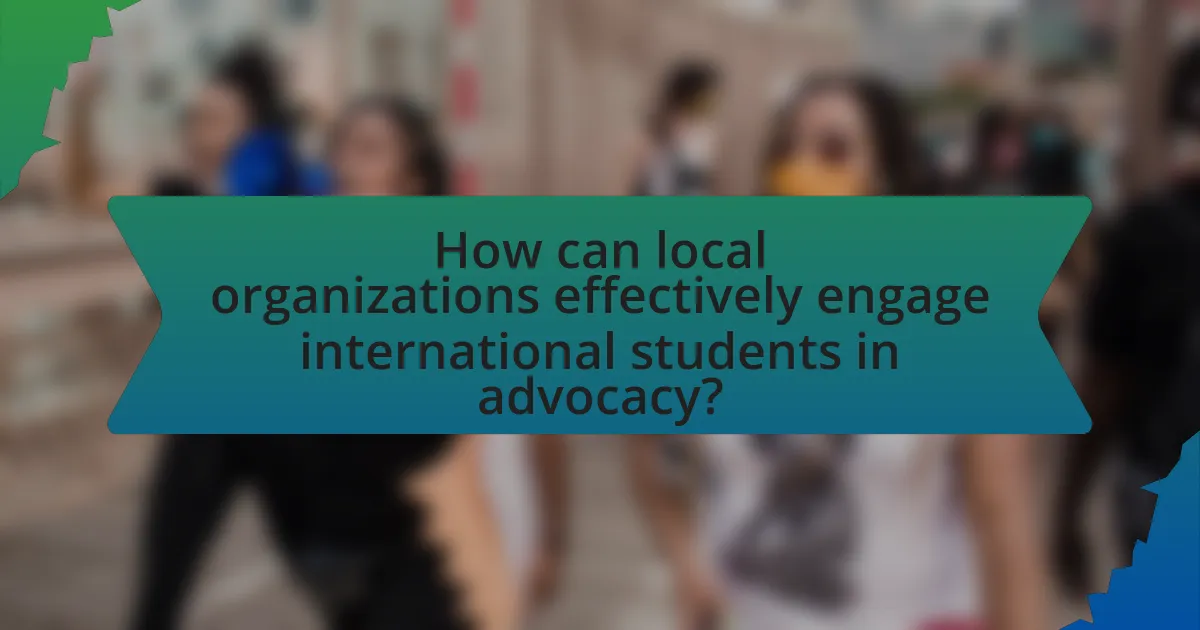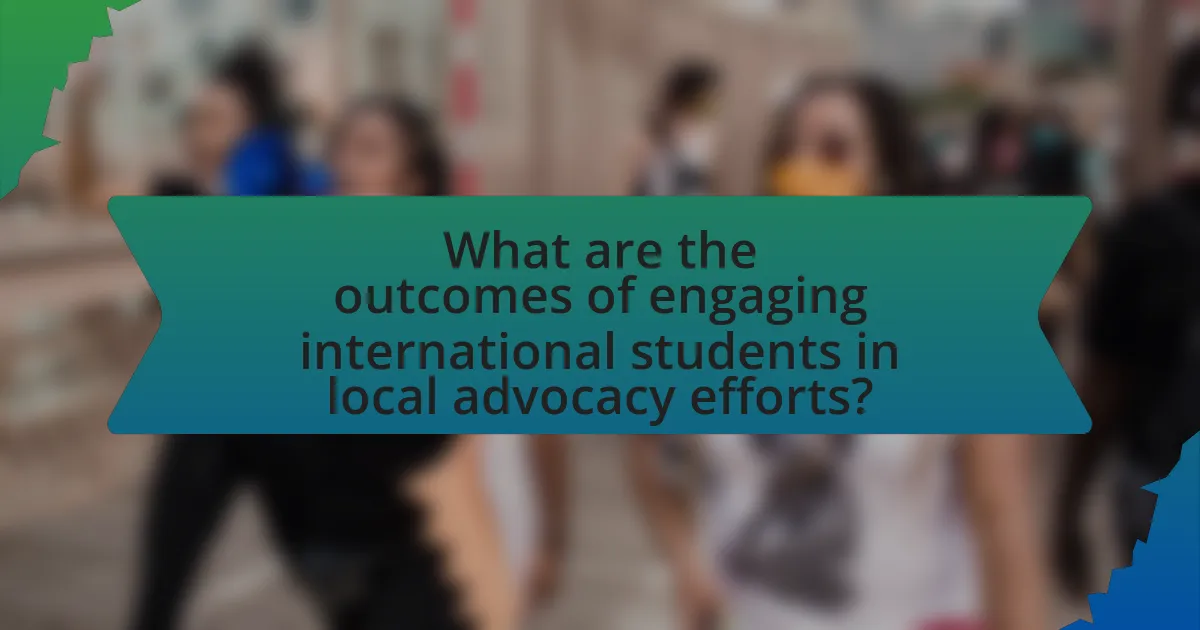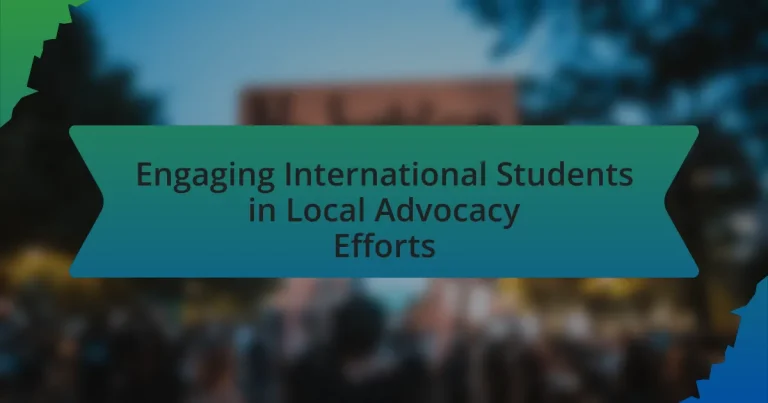Engaging international students in local advocacy efforts involves their active participation in community initiatives addressing social, political, or environmental issues. This article explores the importance of involving international students, highlighting their unique perspectives and contributions to advocacy campaigns. It discusses the benefits of their engagement for local communities, the challenges they face, and strategies for effective involvement, including mentorship programs and the role of social media. Additionally, it examines the skills developed through advocacy participation and the impact on students’ integration into local communities, emphasizing best practices for successful engagement.

What does engaging international students in local advocacy efforts entail?
Engaging international students in local advocacy efforts entails involving them in community initiatives that address social, political, or environmental issues. This participation can include organizing events, collaborating with local organizations, and voicing their unique perspectives on policies affecting their communities. Research indicates that international students often bring diverse viewpoints and experiences, which can enrich local advocacy campaigns and foster cross-cultural understanding. For instance, a study by the Institute of International Education highlights that international students contribute significantly to community engagement, enhancing the effectiveness of advocacy efforts through their active involvement.
Why is it important to involve international students in local advocacy?
Involving international students in local advocacy is important because it enriches the community with diverse perspectives and experiences. Their unique backgrounds can highlight issues that may be overlooked by local residents, fostering a more inclusive dialogue. Research indicates that communities with diverse voices are better equipped to address complex social issues, as they benefit from a wider range of solutions and ideas. For instance, a study by the Institute of International Education found that international students contribute significantly to cultural exchange and community engagement, enhancing local advocacy efforts.
What unique perspectives do international students bring to advocacy efforts?
International students bring diverse cultural insights and global viewpoints to advocacy efforts. Their unique experiences often highlight issues such as immigration policies, educational access, and cultural representation, which may differ significantly from those of domestic students. For instance, international students can provide firsthand accounts of the challenges faced in navigating local systems, thereby enriching discussions on policy reform. Additionally, their varied backgrounds foster a broader understanding of global issues, enabling advocacy groups to address concerns that resonate with a wider audience. This diversity not only enhances the depth of advocacy initiatives but also promotes inclusivity and representation in decision-making processes.
How can local communities benefit from the involvement of international students?
Local communities can benefit from the involvement of international students through cultural exchange, economic contributions, and enhanced community engagement. International students bring diverse perspectives and experiences, enriching local culture and fostering mutual understanding. Their presence can stimulate local economies; for instance, a report from the Institute of International Education indicates that international students contributed over $45 billion to the U.S. economy in 2019, supporting local businesses and creating jobs. Additionally, international students often engage in volunteer work and community service, strengthening local advocacy efforts and addressing social issues. This involvement not only benefits the students by integrating them into the community but also enhances the social fabric of the local area.
What challenges do international students face in participating in local advocacy?
International students face significant challenges in participating in local advocacy, primarily due to language barriers, cultural differences, and legal restrictions. Language barriers can hinder effective communication and understanding of local issues, making it difficult for international students to engage meaningfully in advocacy efforts. Cultural differences may lead to misunderstandings about advocacy norms and practices, which can further isolate these students from local communities. Additionally, legal restrictions, such as visa limitations, can prevent international students from fully participating in advocacy activities, as they may fear repercussions that could affect their immigration status. These challenges collectively impede the ability of international students to contribute to and benefit from local advocacy initiatives.
How do cultural differences impact their engagement in advocacy?
Cultural differences significantly impact engagement in advocacy by shaping individuals’ values, communication styles, and perceptions of social responsibility. For instance, collectivist cultures often prioritize group harmony and consensus, leading to advocacy approaches that emphasize collaboration and community involvement, while individualistic cultures may encourage more assertive and personal expressions of advocacy. Research indicates that international students from collectivist backgrounds may be less likely to engage in confrontational advocacy methods, preferring dialogue and consensus-building strategies, as seen in studies conducted by the Institute of International Education. These cultural frameworks influence not only the methods of advocacy employed but also the motivations behind participation, affecting overall engagement levels in local advocacy efforts.
What barriers exist for international students in understanding local issues?
International students face several barriers in understanding local issues, primarily due to language proficiency, cultural differences, and limited access to information. Language barriers hinder effective communication and comprehension of local news and discussions, making it difficult for students to engage with community issues. Cultural differences can lead to misunderstandings of local customs, values, and social dynamics, which are essential for grasping the context of local issues. Additionally, international students often have restricted access to local media and community resources, limiting their exposure to relevant information and discussions. These factors collectively impede their ability to fully understand and participate in local advocacy efforts.

How can local organizations effectively engage international students in advocacy?
Local organizations can effectively engage international students in advocacy by creating inclusive platforms that encourage participation and representation. These organizations should establish mentorship programs that connect international students with local advocates, facilitating knowledge exchange and skill development. Additionally, organizing workshops and forums that address issues relevant to international students, such as immigration policies or cultural integration, can empower them to voice their concerns. Research indicates that when international students feel supported and included, they are more likely to participate in advocacy efforts, enhancing community engagement and fostering a sense of belonging.
What strategies can be implemented to encourage participation?
To encourage participation among international students in local advocacy efforts, institutions can implement targeted outreach programs that foster a sense of belonging and community. These programs can include mentorship initiatives pairing international students with local advocates, which has been shown to enhance engagement by providing support and guidance. Additionally, organizing culturally relevant events and workshops can create a welcoming environment, as evidenced by studies indicating that inclusive activities increase participation rates by up to 40%. Providing language support and resources also facilitates involvement, as language barriers often hinder engagement. By addressing these specific needs, institutions can effectively boost participation among international students in advocacy efforts.
How can mentorship programs facilitate international student involvement?
Mentorship programs facilitate international student involvement by providing structured support and guidance that helps students navigate cultural and academic challenges. These programs connect international students with experienced mentors who can offer insights into local customs, academic expectations, and professional networking opportunities. Research indicates that mentorship significantly enhances the integration of international students into their host communities, as evidenced by a study published in the Journal of International Students, which found that 75% of participants reported increased engagement in local activities due to mentorship support. This involvement not only fosters a sense of belonging but also encourages active participation in advocacy efforts, thereby enriching both the students’ experiences and the local community.
What role does social media play in engaging international students?
Social media plays a crucial role in engaging international students by providing platforms for communication, community building, and information sharing. These platforms enable international students to connect with peers, access resources, and participate in local advocacy efforts. For instance, a study by the Institute of International Education found that 70% of international students use social media to stay informed about events and opportunities in their host country, facilitating their integration and involvement in local initiatives. This engagement not only enhances their social networks but also empowers them to voice their concerns and contribute to advocacy efforts effectively.
What resources are available to support international students in advocacy efforts?
International students can access various resources to support their advocacy efforts, including university international student offices, student organizations, and community advocacy groups. University international student offices provide guidance on navigating local policies and connecting with advocacy initiatives, while student organizations often focus on cultural representation and can mobilize collective action. Community advocacy groups, such as immigrant rights organizations, offer resources, training, and networking opportunities specifically tailored for international students, enhancing their ability to engage in local advocacy effectively.
How can universities provide support for advocacy initiatives?
Universities can provide support for advocacy initiatives by establishing dedicated programs and resources that empower students to engage in local issues. These programs can include training workshops on advocacy skills, access to funding for student-led initiatives, and partnerships with local organizations to facilitate community involvement. For instance, universities like the University of California, Berkeley, have implemented advocacy training programs that equip students with the necessary tools to effectively address social issues, demonstrating a commitment to fostering civic engagement among their student body.
What community organizations can assist international students in advocacy?
Community organizations that assist international students in advocacy include the International Student Office at universities, which provides resources and support for navigating immigration issues and cultural integration. Additionally, organizations like the National Association of Foreign Student Advisers (NAFSA) advocate for international education policies and provide networking opportunities. Local immigrant and refugee support organizations, such as the International Rescue Committee (IRC) and local chapters of the American Immigration Lawyers Association (AILA), also offer advocacy and legal assistance tailored to the needs of international students. These organizations play a crucial role in empowering students to engage in advocacy efforts effectively.

What are the outcomes of engaging international students in local advocacy efforts?
Engaging international students in local advocacy efforts leads to enhanced cultural exchange and increased community awareness. These students bring diverse perspectives and experiences that enrich local discussions, fostering a more inclusive environment. Research indicates that when international students participate in advocacy, they not only develop leadership skills but also contribute to policy changes that reflect a broader range of community needs. For instance, a study by the Institute of International Education found that international students who engage in local initiatives report higher levels of civic engagement and social integration, demonstrating the positive impact of their involvement on both personal and community levels.
How does participation in advocacy impact international students personally?
Participation in advocacy positively impacts international students by enhancing their sense of belonging and community engagement. When international students engage in advocacy, they often develop stronger connections with local communities, which can alleviate feelings of isolation and cultural dislocation. Research indicates that involvement in advocacy activities fosters personal growth, increases self-efficacy, and improves mental well-being, as students feel empowered to voice their concerns and contribute to societal change. For instance, a study published in the Journal of International Students found that international students who participated in advocacy reported higher levels of satisfaction with their social networks and overall life experiences.
What skills do international students develop through advocacy involvement?
International students develop critical skills such as communication, leadership, cultural competency, and problem-solving through advocacy involvement. Engaging in advocacy allows these students to articulate their perspectives effectively, fostering strong verbal and written communication skills. Leadership skills are honed as they take initiative in campaigns and collaborate with diverse groups. Cultural competency is enhanced by navigating different cultural contexts and understanding various viewpoints, which is essential in advocacy work. Additionally, problem-solving skills are developed as they address challenges and seek solutions within their communities. These skills are vital for personal and professional growth, making international students more competitive in the global job market.
How does advocacy participation influence their integration into the local community?
Advocacy participation significantly enhances the integration of individuals into the local community by fostering connections and building social networks. When individuals engage in advocacy efforts, they often collaborate with local organizations and residents, which facilitates mutual understanding and shared goals. This interaction not only helps individuals to develop a sense of belonging but also allows them to contribute to community issues, thereby increasing their visibility and acceptance within the community. Research indicates that active participation in advocacy can lead to improved social ties and a greater sense of community identity, as evidenced by studies showing that individuals involved in local advocacy report higher levels of community engagement and satisfaction.
What best practices should be followed for successful engagement?
Successful engagement with international students in local advocacy efforts requires fostering an inclusive environment that encourages participation and collaboration. Best practices include actively involving students in decision-making processes, providing clear communication about opportunities, and offering cultural sensitivity training for both students and local advocates. Research indicates that inclusive practices enhance student satisfaction and retention, as evidenced by a study from the Institute of International Education, which found that 85% of engaged international students reported a positive impact on their academic experience. Additionally, establishing mentorship programs can facilitate connections between international students and local community leaders, further enhancing engagement and advocacy outcomes.
How can organizations measure the impact of international student involvement in advocacy?
Organizations can measure the impact of international student involvement in advocacy through quantitative metrics such as participation rates, survey feedback, and policy changes influenced by their efforts. For instance, tracking the number of international students participating in advocacy events provides a clear metric of engagement. Additionally, conducting surveys to assess the perceived effectiveness of their involvement can yield qualitative insights. Furthermore, analyzing specific policy changes or initiatives that resulted from advocacy efforts can serve as concrete evidence of impact. Studies have shown that diverse perspectives, including those from international students, can significantly enhance advocacy outcomes, reinforcing the importance of their involvement.
What are common pitfalls to avoid when engaging international students?
Common pitfalls to avoid when engaging international students include failing to understand cultural differences, neglecting language barriers, and not providing adequate support systems. Cultural differences can lead to misunderstandings and alienation; for instance, assuming that all students share similar communication styles can hinder effective engagement. Language barriers may prevent international students from fully participating in discussions or advocacy efforts, which can diminish their contributions. Additionally, lacking support systems, such as mentorship or resources tailored to international students, can result in feelings of isolation and disengagement. Research indicates that institutions that actively address these issues see higher levels of participation and satisfaction among international students, reinforcing the importance of a thoughtful approach to engagement.
What practical tips can enhance the engagement of international students in local advocacy?
To enhance the engagement of international students in local advocacy, institutions should facilitate opportunities for collaboration with local organizations and community leaders. This can be achieved by organizing workshops that educate students on local issues and advocacy strategies, thereby empowering them to participate actively. Research indicates that when students are provided with structured support and resources, such as mentorship programs and networking events, their involvement in advocacy efforts increases significantly. For instance, a study by the Institute of International Education found that students who engage in community service and advocacy report higher levels of satisfaction and integration within their host communities.




